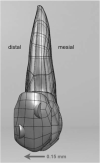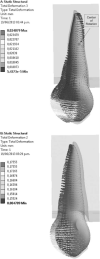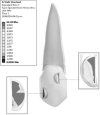Initial force systems during bodily tooth movement with plastic aligners and composite attachments: A three-dimensional finite element analysis
- PMID: 25181252
- PMCID: PMC8612436
- DOI: 10.2319/050714-330.1
Initial force systems during bodily tooth movement with plastic aligners and composite attachments: A three-dimensional finite element analysis
Abstract
Objective: To describe, using a three-dimensional finite element (FE) model, the initial force system generated during bodily movement of upper canines with plastic aligners with and without composite attachments.
Materials and methods: A CAD model of an upper right canine, its alveolar bone and periodontal ligament, thermoformed plastic aligner, and two light-cured composite attachments were constructed. A FE model was used to analyze the effects of imposing a distal movement condition of 0.15 mm on the aligner (simulating the mechanics used to produce a distal bodily movement) with and without composite attachments.
Results: In terms of tension and compression stress distribution, without composite attachments a compression area in the cervical third of the distal root surface and a tension area in the apical third of the mesial surface were observed. With composite attachments, uniform compression areas in the distal root surface and uniform tension area in the mesial root surface were observed. Compression areas in the active surfaces of the composite attachments were also observed. In terms of movement patterns, an uncontrolled distal inclination, with rotation axis between the middle and cervical root thirds, was observed without composite attachment. Distal bodily movement (translation) was observed with composite attachment.
Conclusions: In a three-dimensional FE analysis of a plastic aligner system biomechanically supplementary composite attachments generate the force system required to produce bodily tooth movement; the absence of biomechanically supplementary composite attachments favors the undesired inclination of the tooth during the translation movements.
Keywords: Bodily movement; Finite element; Plastic aligners.
Figures








References
-
- Hayashia K, Araki Y, Uechi J, Hiroki Ohno H, Mizoguchi I. A novel method for the three-dimensional (3-D) analysis of orthodontic tooth movement calculation of rotation about and translation along the finite helical axis. J Biomech. 2002;35:45–51. - PubMed
-
- Jones ML, Hickman J, Middleton J, Knox J, Volp C. A validated finite element method study of orthodontic tooth movement in the human subject. J Orthod. 2001;28:29–38. - PubMed
-
- Cattaneo PM, Dalstra M, Melsen B. The finite element method: a tool to study orthodontic tooth movement. J Dent Res. 2005;84:428–433. - PubMed
-
- McGuinness BN, Wilson AN, Jones M, Middleton J, Robertson NR. Stresses induced by edgewise appliances in the periodontal ligament—a finite element study. Angle Orthod. 1992;62:15–22. - PubMed
-
- Kusy RP. Influence of force systems on archwire-bracket combinations. Am J Orthod Dentofacial Orthop. 2005;127:333–342. - PubMed
MeSH terms
Substances
LinkOut - more resources
Full Text Sources
Other Literature Sources
Miscellaneous

